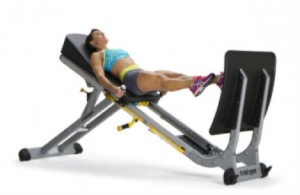No lower extremity rehab process is complete until the athlete or client can control eccentric actions on a single leg. Unfortunately, the process of getting an athlete to take off and land on one leg can be a difficult one. Frequently athletes are cleared to participate in sports who have not done any single leg plyometric activities.
In order to truly understand lower extremity rehab it is important to understand the difference between unilateral take offs and landings and bilateral takeoffs and landings. It is also important to understand that running is a just series of unilateral takeoffs and landings.
In rehab settings, unilateral strength exercises like step ups, step downs and various types of single leg squats are widely performed and widely accepted. However, the process of extending or expanding the rehab into the area of eccentric strength and power is more difficult and probably given less consideration.
To further clarify, think of eccentric strength as the braking system. Any client who has experienced a lower body injury or who is returning from a lower body surgery must be able to land effectively to avoid re-injury.
These landings take three forms:
Jumps- a double leg take off followed by a double leg landing
Hops- a single leg take off followed by a landing on the same limb
Bounds- a single leg take off followed by a landing on the opposite limb
What becomes difficult for therapists and athletic trainers is figuring out how to gradually return an athlete to jumping, hopping and bounding as a sequential part of the rehab process. Unfortunately in most rehab settings bodyweight is a constant that must be accounted for.
In order to counter the effect of bodyweight we utilize equipment like the MVP Shuttle and Total Gym Jump Trainer. Both pieces allow athletes to jump and eventually hop with loads that are less than bodyweight. With both pieces we are able to add velocity and a graduated eccentric load.

If you are involved in lower extremity rehab one or both of these pieces becomes a “must have” in your clinical setting. The great thing about both pieces is that you can work towards bodyweight jumps and hops in a very gradual way in conjunction with your lower body, strength oriented, rehab progressions.
It is important to remember that in sport what goes up, must come down and that for every action, there is an equal and opposite reaction. The patella-femoral issues we see so often in rehab are very likely caused, at least in part, by our inability to properly develop the essential braking system. Remember, restoring the ability of the system to move from zero to sixty is inconsequential when there is no braking system.
If your job is rehab, you owe it to yourself and your athletes to take the time to experiment with both the MVP Shuttle and the Total Gym Jump Trainer.
from Michael Boyle's Strengthcoach.com Blog https://strengthcoachblog.com/2016/03/14/unilateral-plyometrics-in-a-rehab-setting/
Visit Us At: via IFTTT

No comments:
Post a Comment